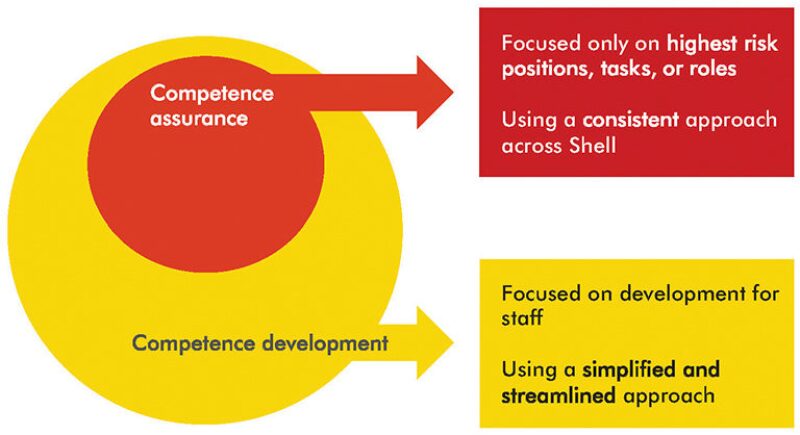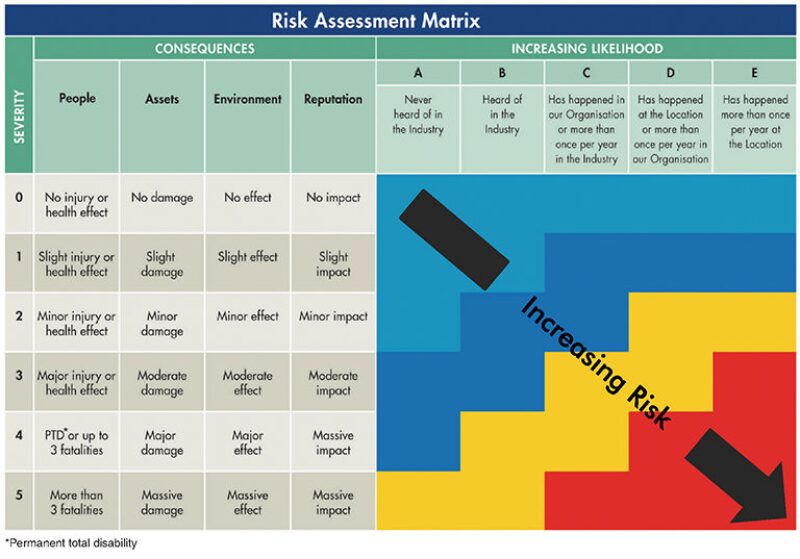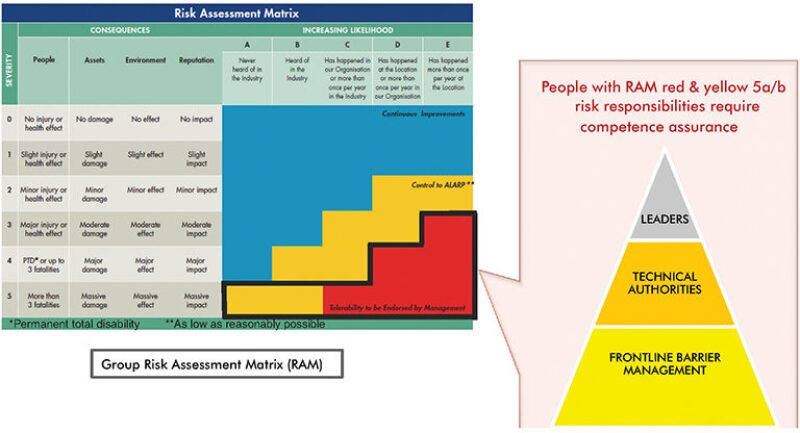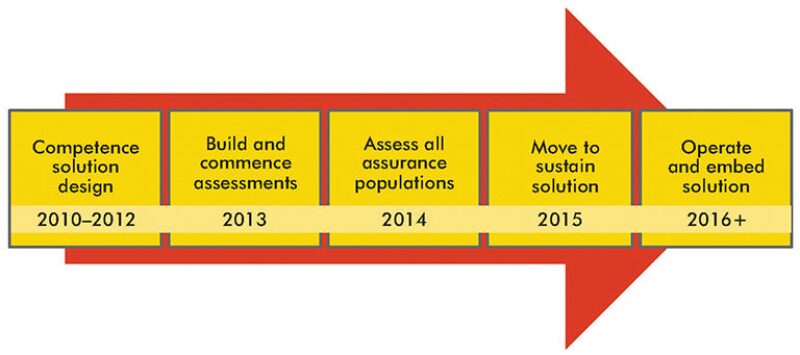In 2001, Shell began globalization of competence management with the implementation of its SAP human resources information technology (IT) platform. Hoping to capitalize on this IT investment, Shell’s various disciplines and functions began enthusiastic efforts to create competence frameworks and job competency profiles that could be managed within a single repository. The following decade of organic growth resulted in a proliferation of competence frameworks that blanketed the organization. Complexity, inconsistency, and redundancy were some of the unintended consequences of leveraging a global IT platform without tightly managing the overarching competence management practices.
When Shell reviewed its competence management infrastructure in early 2010, pockets of excellence surfaced. Unfortunately, for most areas the value of competence management was crumbling under the weight of over-engineered deployments. Capturing large volumes of data on employees’ competencies was deceptively attractive and comforting to management as well as those in the organization tasked with managing workforce capability. However, these data did not necessarily translate to valid or reliable information at an aggregate level for a variety of reasons, most notably due to inconsistencies associated with assessments. As the repository grew, managing ever-changing individual competence data proved cumbersome and problematic. Competence management was clearly presenting several challenges, tensions, and dilemmas. In short, leadership knew the approach was missing the mark against an increasingly dynamic internal and external environment.
Framing the Opportunity
Leadership was intent on successfully challenging longstanding approaches to competence management and applied a project management methodology typically reserved for capital projects. The project commenced in 2010 with an “opportunity identification” phase and the subsequent framing of the opportunity. By the time the project go/no go decision gate was reached, the project’s decision review board, which consisted of several of Shell’s top executives, had a clear picture of the prize as well as the challenges and global impacts of a project of this scale. With a “go” decision reached, Shell was now on its way to developing a new solution for competence management aimed at delivering tangible outcomes:
- Simplify and strengthen the relevance and value of the individual development process.
- Define and win acceptance for a pragmatic, common, risk-based approach to allow business directors to demonstrate that health, safety, security, and environment (HSSE)-critical positions have been identified and filled by people with the requisite competencies. Staff in these positions design, implement, or maintain barriers established for managing major accident risks or are line leaders in organizations with these risks.
During the early stage of the project, there was plenty of skepticism across the organization that the project could achieve a profound change in Shell’s entrenched processes. The challenge of defining a new global solution was exacerbated by issues related to stakeholder control, perceived regrets, and individual bias. It was clear that many stakeholders had vested interests in maintaining the competence management practices they had built. Additionally, since competence management practices touched everyone in the organization, most had strong opinions and believed they spoke from a position of expertise based on the highs and lows of their own experience. From the start, there was an appreciation that change would not be easy and would require significant energy to win over the hearts and minds of a global community on a very personal and emotive topic.
Creating a Strategy
Shell’s competence management strategy created a clear distinction between competence development and competence assurance. Ambiguity evolved over time between these two concepts in large part from the ways competencies were managed in the organization’s IT system. Regardless, whether a competency was needed to manage major accident risk or to simply support effective job performance, the process of assessing, storing, tracking, and reporting competencies was essentially the same. Competencies were assigned based on job competency profiles or HSSE-critical position requirements and self-assessed with manager review and approval. The exception to this was in operational areas where competencies for assurance were managed at the local site level using a variety of assessment methods that were later leveraged as internal best practices. Fig. 1 (above) shows an example of competencies in the IT tracking system.
Fig. 2 illustrates how Shell now distinguishes competence assurance and development. The solution was based on the belief that not all risks are equal and only a subset of competencies and roles in Shell required assurance. The majority of competencies across the organization were developmental in nature. These non-assured or developmental competencies were viewed as competencies that contribute to individual performance and are important to the organization’s overall capability, but presented no need to be managed with the same rigor as competencies critical to major accident risk management. From a human performance perspective, lack of a developmental competency could affect value creation but did not present risk in the execution of safety-critical activities.

Shifting mental models relative to competence development and assurance was difficult for many in the organization. Employees were accustomed to seeing their competencies in the IT system and having control to self-assess with manager approval. Self-assessment with managerial approval was viewed as a valid, practical, and long-standing approach for managing all the competencies stored in the IT system. However, this approach was insufficient for the more rigorous assurance standards that were established and overcomplicated for the more individualized development strategy.
To simplify competence development and sustain a heavier investment in assurance, the complexity of the existing landscape needed to be reduced. In response to this challenge, all disciplines and functions conducted a holistic review of their competence management infrastructure. Reviews were conducted in accordance with new guidelines that were based on consultation with external thought leaders as well as internal and external best practices. The exercise resulted in a 75% reduction in competencies and job competency profiles across Shell.
Competence Assurance Solution
The strategic intent behind the new competence assurance solution was to create a clear framework for targeting people who manage major accident risk and need competence assurance. Each solution was designed in line with the company’s risk assessment matrix (Fig. 3), which defines thresholds for the likelihood and impact of any potential risk. The competence assurance solutions seek to address any circumstance where a lack of competence within a clearly defined workforce population has the potential to affect major accident risk management.

The assurance solution with the smallest population covers HSSE-critical leaders. Relevant employees are defined as senior line management in organizations with major accident risk responsibilities. The “leader” group also includes operations or technical management positions responsible for defining or delivering risk management for major accident risks. The intermediate population includes Shell’s technical authorities who are designated experts charged with safeguarding the integrity of technical decisions in areas with the potential for major accident risks. The largest assured population covers frontline barrier management staff. These are staff in operational positions that directly implement or maintain barriers to major accident risks (Fig. 4).

Once assurance populations were defined, each associated role was reviewed against the applicable competence framework (e.g., well engineering, production operations) and/or risk-based activity. Competencies and activities with the potential to impact targeted risk management levels were flagged for assurance and assigned to individuals. Assessment protocols that specified how competence would be assessed were then designed based on consultation with internal and external assessment experts. The aim was to achieve a level of rigor in the assurance processes such that results delivered “competent and can show it” outcomes. The cornerstones of the assessment protocols were:
- Clearly defined populations. Focusing competence assurance strictly on the highest-risk positions and competencies as documented in Shell’s HSSE control framework
- Qualified assessors. Requiring the use of trained and qualified assessors
- Valid and reliable assessments. Requiring the use of structured assessments to ensure “skill” level proficiency
- Monitoring and control. Tracking results (competent or not yet competent) in one IT system with companywide reporting capability
Once assurance protocols were in place, subject matter experts (SMEs)were trained in assessment development and tasked with developing assessments. SMEs were provided access to internal and external assessment experts as needed to ensure quality. The new assurance protocols and supporting infrastructure represented a material improvement over the more subjective practices used in the past.
Competence Development Solution
The strategic intent behind the new competence development solution was simplicity and employee value. The shift was in moving away from reviewing an extensive list of tick boxes in an IT system to promoting a deeper and more individualized conversation between the employee and his/her line manager based on simplified competence material. Using the tick boxes as the foundation of the annual development process made the annual review exercise an administrative activity, which detracted from the quality of a personalized conversation. The former process was based on the employee self-assessing in the system followed by the line manager receiving an electronic notification prompting them to validate the employee’s self-assessment. The tick boxes were based on job competency profiles that in some cases attempted to serve as a guide for the development needs of hundreds of staff. The relevance of the job competency profile to the actual job that an individual performed was often a stretch.
The development conversation today focuses on the manager and employee working together to co-create an individual development plan, focusing on the key competence development areas required for the current role with an eye toward future roles. This is a significant improvement from the past as employees had so many assigned competencies that it was difficult to determine where to focus and what to prioritize for development. Now employees refer to a simplified job competency profile as a reference and the focus is on what the employee and manager believe is most relevant for the employee’s development and growth.
Business Results to Date
The competence management project spanned a 5-year period beginning in 2010 and achieved all the goals defined during the opportunity framing process within the timeline shown in Fig. 5.

The project was by no means easy. Every design decision involving people development as well as data and risk management was fueled by passionate debates and challenges from numerous global stakeholders. From a best practice perspective, there were two critical success factors for the project. The first was that the solution was based on a set of strategic choices that were grounded on carefully vetted facts, beliefs, and values. These choices guided all decisions affecting the design of the solution. The second was in the alignment and collaboration between human resources, HSSE management, and the line in working together to deliver a common organizational goal. The result has been the successful implementation of what is a highly auditable and sustainable solution that has fundamentally improved and fully globalized how competence is managed.
From a competence development perspective the feedback has been good. Employees have expressed they do not miss reviewing the extensive list of competencies each year. Also, the sky has not fallen with the removal of employee developmental competencies from the IT system. While some still want granular data on employee competencies, the conversation is shifting to discussing more relevant and mature strategies for assessing aggregated organizational capability as was the goal. From an employee value proposition, the idea was to put individual development squarely in the hands of employees and their line managers to enable more focused and relevant planning, rather than having the focus be on filling in tick boxes in an IT system.
SPE’s Competency Management Tool
SPE recently partnered with International Human Resource Development Corporation to create an SPE Competency Management Tool, which is free to members. The tool can be used to assess the competencies needed to perform specified key technical jobs in the oil and gas industry.
The tool will identify competency gaps and help members develop individual learning plans to close these gaps. Learning plans will refer users to SPE training resources, along with resources offered by sister organizations, such as the Society of Exploration Geophysicists and the American Association of Petroleum Geologists, and also to generic course titles reflecting those offered by third-party course providers.
In developing a learning plan, the user will be able to choose priorities for closing competency gaps, select the most appropriate learning resources, and determine the pace at which learning should take place. For more information, please go to www.spe.org/training/cmt.
From a competence assurance perspective, the project goal was to have all targeted populations “audit-ready” by 1 January 2015. Audit-ready meant that more than 90% of HSSE-critical positions have assessments and gap closure plans in place (<10% factoring in turnover and staff movement). The audit-ready goal was aggressive given that the majority of assurance-based assessments were developed in 2013 and only available in most cases by the beginning of 2014. This meant that all targeted organizations had 12 months to assure their populations against rigorous assessment protocols. The assured population in Shell represents about 20% of the workforce. In considering the assurance population numbers in light of the 80/20 rule, these numbers seem right. At the time of this writing, the competence assurance process recently concluded a self-imposed internal audit. The internal audit further validated the effectiveness of the solution’s overall implementation and management as well as offered recommendations for further enhancement.
Conclusion
For more than 30 years, the vast majority of organizations have implemented some form of competence management. Despite best intentions, most have struggled with the design, integration, and sustainability of their programs. Given that backdrop, nowhere is effective competence management more critical than in high-risk industries such as oil and gas where the threat of catastrophic failure exists daily. Shell’s 5-year journey sought to address some of the universal challenges of competence management along with several internal improvement opportunities. In doing so, the company challenged many of its long-held competence management practices and underlying assumptions. The result has been the global implementation of a strategic solution that fundamentally reshaped how competence is managed.
Brent A. Kedzierski is learning manager for Shell Upstream Americas. He holds an MA degree in human resource management from Marymount University and a BS degree in training and communications from Indiana University of Pennsylvania.

